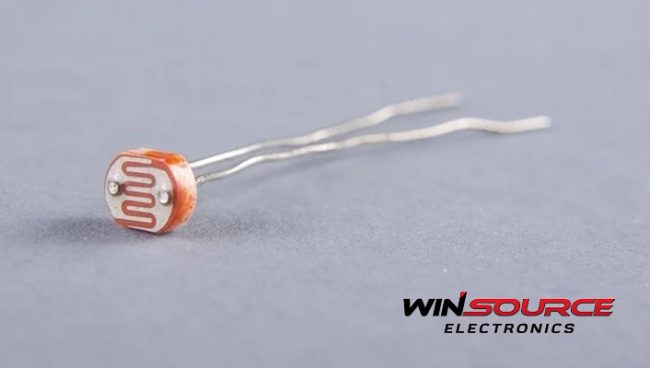
Photoresistor what is it and how does it work?
A photoresistor has become a key component in modern electronics, playing a indispensable role in light sensing technology. Known for their ability to change resistance based on light intensity, photoresistors are essential in a myriad of applications. From automatic lighting to intricate sensing systems. We will explore the functionality, uses, and comparisons of photoresistors.
What is a photoresistor?
A photoresistor is a type of resistor whose resistance varies with changes in light intensity. Typically, in dark conditions, a photoresistor exhibits high resistance, while its resistance decreases significantly under bright light. This unique property makes photoresistors particularly useful in circuits where light sensitivity is required.
Commonly made from semiconductor materials, photoresistors are simple yet effective in translating light signals into electrical signals. This functionality is crucial in applications that rely on the presence or absence of light for operation.
How does a photoresistor work?
The working principle of a photoresistor is centered around its light-sensitive nature. When exposed to light, the semiconductor material within the photoresistor absorbs photons. This absorption energizes electrons, causing them to jump from the valence band to the conduction band, leading to a decrease in resistance.
The level of resistance change depends on the intensity of the light. This variable resistance property of photoresistors is what makes them ideal for applications that require automatic adjustments based on ambient light levels.
Photodiode vs Photoresistor
When comparing photodiodes with photoresistors, it’s important to understand their distinct characteristics. Photodiodes are specialized to convert light into an electric current, making them ideal for applications requiring fast response times and precision. In contrast, photoresistors are better suited for applications where a simple, cost-effective light sensor is needed, with less emphasis on response time and accuracy.
While photodiodes offer better control and efficiency. Photoresistors are preferred for their simplicity and ease of integration in circuits that don’t demand high-speed or high-precision light detection.
What does a photoresistor do?
Photoresistors are used in various applications to detect and respond to light. One common application is in automatic lighting systems, where the photoresistor controls the on/off state of lights based on the ambient light level. They are also used in light meters, alarm systems, and devices that need to respond to changing light conditions, such as night lights and street lamps.
Their ability to adapt to light changes makes photoresistors an excellent choice for energy-saving devices and systems that require automation based on environmental light.
LDR: another name for photoresistor
Photoresistor, also widely known as a Light Dependent Resistor (LDR), is a key component in light-sensitive circuits. The term LDR encapsulates perfectly the essence of a photoresistor: a resistor that changes its resistance based on light intensity. LDRs are made from high-resistance semiconductor materials that respond significantly to light exposure.
LDRs find their use in devices where it’s crucial to detect the presence or absence of light. They are often used in applications like automatic street lights, where the lights turn on or off depending on the ambient light, and in light-sensitive alarm systems.
Key features and advantages of photoresistors
Photoresistors, or LDRs, offer several features and advantages that make them ideal for different applications:
- Variable resistance: Their resistance changes with the intensity of light, providing a simple yet effective way to measure light levels.
- Cost-effective: LDRs are generally less expensive than other light-sensing options, like photodiodes or phototransistors.
- Easy to use: They can be easily integrated into circuits without the need for complex circuitry or additional components.
- Versatility: Suitable for a range of applications, from simple light detection to complex image processing.
- Long lifespan: When used correctly, a LDR can have a long operational life, making them a reliable component in long-term projects.
These characteristics underscore why a photoresistor is a popular choice in both educational settings for teaching basic electronics. And in professional settings for building sophisticated electronic systems.
The role of photoresistors in modern technology
In today’s technology, photoresistors play an important role. They are not just limited to basic light sensing but are integral in more complex systems like optical switches, safety devices, and even in some types of image processing equipment. The evolution of photoresistor technology continues to open new avenues in electronic design. And making them an indispensable component in the development of smart, responsive technology.
Future trends and innovations in photoresistor technology
The future of photoresistor technology looks promising, with ongoing research and development. Innovations focus on enhancing sensitivity, reducing response time, and integrating LDRs with newer technologies like IoT (Internet of Things). These advancements aim to create more responsive and energy-efficient systems, extending the applications of photoresistors far beyond their current scope.
As LDR technology evolves, we can expect to see them becoming an even more integral part of smart home systems, environmental monitoring, and perhaps even in new areas like interactive art installations. The potential for these simple yet versatile components is vast and continues to grow with each technological breakthrough.
WIN SOURCE: Your source for high-quality photoresistors
WIN SOURCE understands the importance of reliable and efficient components in electronic projects. That’s why we offer a wide range of resistors, suitable for various applications. Whether you need a basic light sensor or a component for a sophisticated system, our selection of photoresistors is designed to meet your needs.
With WIN SOURCE, you get access to high-quality photoresistors that bring precision and efficiency to your projects. Visit our product store and find the perfect photoresistor for your next innovative project, assured of quality and performance.
© 2025 Win Source Electronics. All rights reserved. This content is protected by copyright and may not be reproduced, distributed, transmitted, cached or otherwise used, except with the prior written permission of Win Source Electronics.

COMMENTS